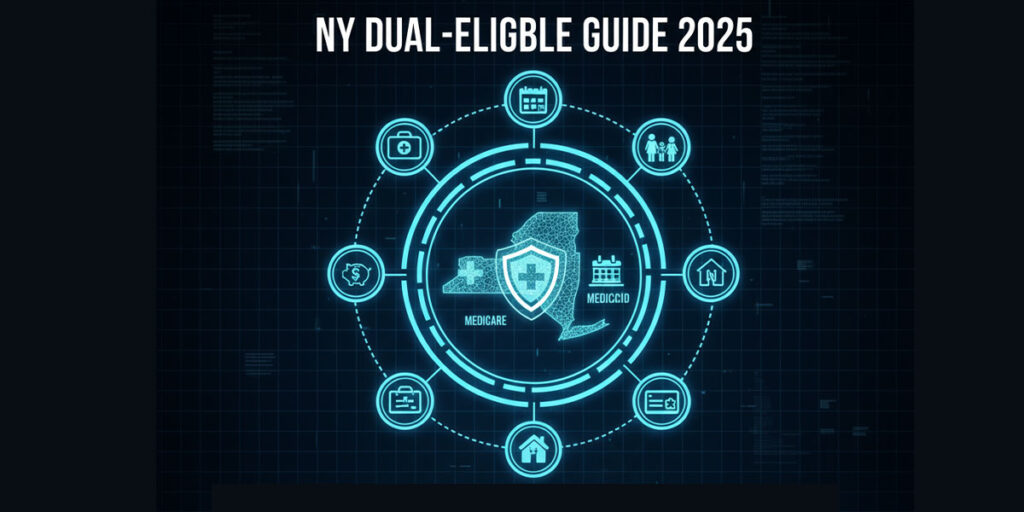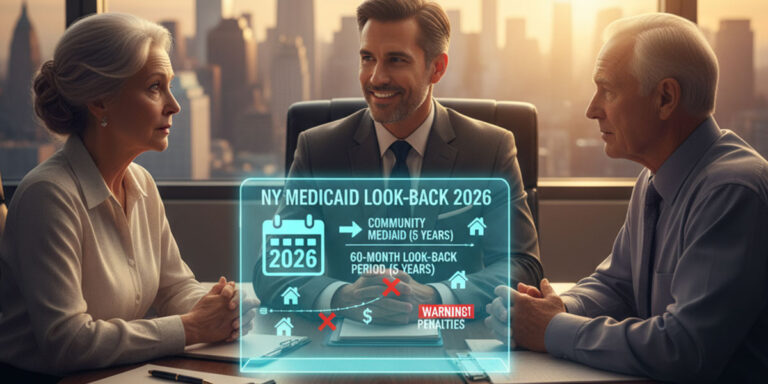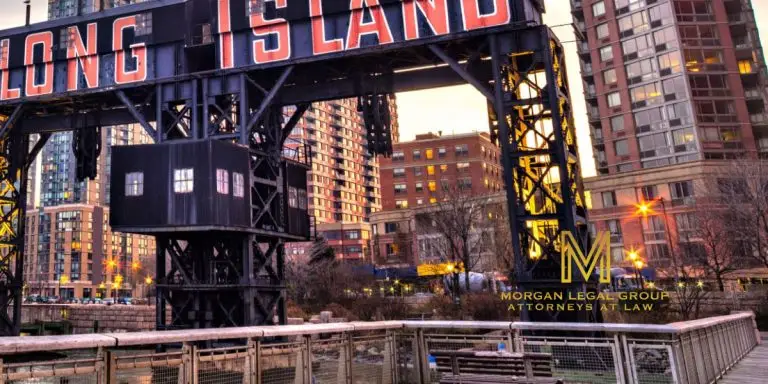Medicare vs. Medicaid: NY 2025 Guide
It is the single most dangerous myth in American healthcare. And if you are a New Yorker over the age of 65, believing it will cost you and your family everything you have worked for, starting with your home. Here is the myth: “I have Medicare, so I am covered for long-term care.”
As a New York elder law attorney with over 30 years of experience, I, Russel Morgan, have seen this misunderstanding destroy families. Let me be unequivocally clear: Medicare does NOT pay for long-term care.
Medicare is your health insurance. It pays for your doctors. It pays for your hospital stays. It pays for your prescriptions. It does *not* pay for the “custodial” care that 70% of seniors will eventually need. This is the non-medical help with daily living—bathing, dressing, eating. This care, whether at home or in a facility, costs $15,000 to $25,000 *per month* in the New York City area. It will bankrupt 99% of families in less than a year.
So, what is the solution? Medicaid. Medicaid is the *only* government program that pays for this devastatingly expensive long-term care. The goal for most seniors is to become “dual-eligible,” where Medicare pays your medical bills and Medicaid pays your long-term care bills.
But here is the 2025 crisis: Qualifying for Medicaid in New York just became exponentially harder. Two massive rule changes have created a perfect storm for seniors. A new, stricter physical requirement (the 3-ADL rule) just went into effect. And a “ticking time bomb” financial rule (the 30-month look-back) is set to explode any day, slamming shut the last window for asset protection. This is the definitive 2025 guide to navigating this crisis. Failure to understand these changes is no longer an option. Contact us today before it is too late.
The Great Divide: What Medicare Pays For vs. What Medicaid Pays For
You cannot plan for your future until you understand this fundamental difference. These two programs serve entirely different purposes. Confusing them is a multi-million dollar mistake.
Medicare’s Role: Your Health Insurance (The “Doctor Bill Payer”)
Think of Medicare as your primary health insurance. It is an “entitlement” program. You paid into it your whole life, and you get it at age 65 regardless of your wealth. It is broken into several parts:
- Part A (Hospital Insurance): Pays for your hospital room, inpatient care, and *very* limited skilled nursing care.
- Part B (Medical Insurance): Pays for your doctor’s visits, outpatient services, and medical equipment.
- Part D (Prescription Drugs): Your prescription drug plan.
Medicare’s coverage is for *acute* or *rehabilitative* care. It is designed to get you “better.” It is not designed to *maintain* your life with chronic illness or frailty. This leads to the “100-Day Myth.”
The “100-Day Myth”: Medicare’s Biggest Lie
People often say, “Medicare pays for the first 100 days in a nursing home.” This is dangerously misleading. Medicare *only* pays for “skilled nursing” care in a rehabilitation facility *after* you have had a “qualifying” 3-day inpatient hospital stay. Furthermore, it only pays 100% for the first 20 days. After that, you face a large co-pay.
Most importantly, the moment your care is deemed “custodial” (meaning you are not “improving” or “rehabilitating”), Medicare cuts off your coverage. This can happen on Day 10, Day 30, or Day 1. Medicare does *not* pay for custodial care. This is the care most seniors need.
Medicaid’s Role: Your Long-Term Care Solution (The “Life Savings Payer”)
Medicaid, in contrast, is a “needs-based” program. It is designed for those who have limited income and assets. It is the *only* program that pays for the two most expensive things a senior will ever face:
- Community Medicaid: Pays for home health aides, personal care assistants, and adult day care, allowing you to stay in your own home.
- Institutional Medicaid: Pays the $15,000-$25,000 monthly bill for a skilled nursing home.
The entire goal of elder law is to legally and ethically restructure your assets so you can qualify for the Medicaid benefits you have paid taxes for your entire life, without losing your home and life savings in the process. This is where “dual-eligible” status becomes the primary objective.
The “Dual-Eligible” Advantage: How Medicaid *Helps* Your Medicare
Many seniors fear that “going on Medicaid” means they “lose their Medicare.” This is 100% false. In fact, for a senior with limited resources, becoming dual-eligible is the single best-case scenario. When you are dual-eligible, Medicare remains your *primary* insurer, and Medicaid acts as the best supplemental plan in the world.
Benefit #1: Medicaid Pays Your Medicare Premiums and Co-Pays
This is the most immediate financial relief. For most seniors, the Medicare Part B premium (and for some, Part A) is a significant monthly expense deducted from their Social Security. Medicaid can pay this for you through a “Medicare Savings Program” (MSP).
In New York for 2025, the MSPs are incredibly generous:
- QMB (Qualified Medicare Beneficiary): If your income is at or below 138% of the federal poverty line (approx. $1,732/mo for one person), you qualify. Medicaid will pay your entire Part B premium, your Part A premium (if you have one), AND all of your Medicare deductibles and co-payments.
- QI (Qualifying Individual): If your income is slightly higher (up to approx. $2,446/mo for one person), you can qualify for the QI program. Medicaid will pay your entire Part B premium.
Here is the crucial part: New York has eliminated the asset test for Medicare Savings Programs. This means you could have $500,000 in the bank, but if your *income* is low enough, you can still qualify for Medicaid to pay your Medicare premiums. This is a massively underutilized benefit.
Benefit #2: Medicaid Pays for What Medicare Denies
This is the big one: long-term care. When your doctor says you need a home health aide 8 hours a day, Medicare says no. Medicaid says yes. Medicaid will cover the full cost of that aide, allowing you to age in your home. This is the benefit that protects your home from being sold to pay for your care.
Medicaid also covers other items Medicare does not, such as dental, vision, hearing aids, and transportation to medical appointments. It is a comprehensive safety net that wraps around your primary Medicare coverage.
The 2025 Crisis, Part 1: The New 3-ADL Physical Hurdle
For decades, qualifying for home care in New York was relatively straightforward. You had to show a medical need, often for just one or two “Activities of Daily Living.” As of September 1, 2025, that has changed. The bar has been raised.
What are “Activities of Daily Living” (ADLs)?
ADLs are the basic tasks of self-care. There are six primary ADLs that Medicaid assesses:
- Bathing: Ability to wash oneself.
- Dressing: Ability to get clothes and put them on.
- Toileting: Ability to get to and from the toilet and clean oneself.
- Transferring: Ability to move from a bed to a chair, or a chair to standing.
- Continence: Ability to control one’s bladder and bowels.
- Eating: Ability to feed oneself (not cooking, but the physical act of eating).
The Old Rule vs. The New Rule (Post-Sept 1, 2025)
This is a major policy shift.
- The Old Rule: You generally only needed to show a need for “cuing, supervision, or assistance” with one or two ADLs to get a significant number of home care hours.
- The New Rule: For all *new* applications after September 1, 2025, you must prove you require “limited assistance with physical maneuvering” for at least THREE (3) ADLs.
This is a much higher physical threshold. A person who is forgetful and needs help with medication but can still physically dress and bathe themselves may now be denied. This new rule targets those in the early to mid-stages of decline, forcing families to wait until the applicant is *more* debilitated before help is provided.
The Dementia/Alzheimer’s Exception
There is a small exception. If you have a formal diagnosis of dementia or Alzheimer’s, the new rule is slightly different. You must show a need for “supervisory assistance” for at least **TWO (2) ADLs**. This is still a higher bar than before.
This new 3-ADL rule makes the application process itself far more adversarial. It is no longer enough to just “need help.” You must have your needs professionally documented by doctors and an NYC elder law attorney to fit these new, rigid definitions. Failing to frame your application correctly will result in a denial, leaving you with Medicare as your only coverage—which, as we know, pays $0 for this care.
The 2025 Crisis, Part 2: The 30-Month Look-Back Ticking Clock
This is the “ticking time bomb” of New York elder law. As of this writing in November 2025, it has *not yet* been implemented. This has created a “last chance” window of opportunity that is closing fast.
The “Golden Age” of NY Home Care (What We Had Until Now)
For decades, New York had a “golden” rule.
- Nursing Home (Institutional) Medicaid: This *always* had a 5-year (60-month) “look-back.” If you applied, Medicaid scrutinized your finances for the last 5 years. Any gift you made triggered a penalty.
- Home Care (Community) Medicaid: This had **NO LOOK-BACK**.
This “no look-back” rule for home care was the most powerful estate planning tool in the state. It allowed for “crisis planning.” A client could come to our office, have a stroke, and need home care *tomorrow*. We could legally transfer their home and assets into a trust on Monday, and they would be financially eligible for Medicaid on Tuesday. This saved countless families from bankruptcy.
The New Rule: The 30-Month (2.5-Year) Look-Back
The New York State budget passed in 2020 authorized a new 30-month look-back for Community Medicaid. Its implementation was delayed by the pandemic, but it is expected to go into effect any day. Once it does, “crisis” home care planning will be dead. The “Golden Age” will be over.
When this rule is implemented, anyone applying for home care will have their finances scrutinized for the last 2.5 years. Any transfer, any gift, any asset moved for less than fair market value will be penalized.
How the Penalty Period Bankrupts Families
The penalty is calculated with a simple, brutal formula: Total Gift Amount ÷ Regional Medicaid Rate = Months of Penalty.
The “Regional Rate” is a number set by Medicaid for what they deem the average cost of care. In Long Island for 2025, this rate is approximately $14,500/month.
- Example: You gave your daughter $100,000 for a down payment on her house last year.
- You apply for home care *after* the look-back is implemented. Medicaid finds this $100,000 gift.
- Calculation: $100,000 ÷ $14,500 = 6.89 months.
The Result: Medicaid will not pay for your care for the first 6.89 months. You must pay for your 24/7 home care ($18,000/month) yourself. You will pay over $124,000 *out of pocket* because of that $100,000 gift. This is how families lose everything.
What Is a “Transfer” or “Gift”?
It is anything you gave away without getting “fair market value” in return.
- Giving your house to your children.
- Selling your $800,000 Brooklyn home to your son for $1.
- Giving a grandchild $20,000 for college.
- Adding a child’s name to your bank account (this is a 50% gift).
- Donations to your church or charities.
All these well-intentioned acts will soon disqualify you from care.
The “Last Chance” Window of 2025
As of November 2025, this 30-month look-back is *NOT YET* in effect. This means we are in the most urgent planning period I have ever seen in my 30-year career. Anyone who applies for Community Medicaid *before* the implementation date is grandfathered in under the old “no look-back” rules. This is a race against the clock. Scheduling a consultation today is the only way to take advantage of this closing window.
Qualifying for NY Medicaid: The 2025 Financial Hurdles
Even if you meet the 3-ADL physical test, you must meet the financial tests. This is where most people who only have Medicare fail. They are not “poor enough” for Medicaid.
Hurdle #1: The 2025 NY Medicaid Asset Limits (The “Resource Test”)
These are the 2025 limits for “countable” assets (bank accounts, stocks, non-home real estate).
- Single Applicant: $30,182
- Married Couple (both applying): $40,821
This is a shockingly low number. However, many assets are “exempt,” such as one car, pre-paid burial plots, and, most importantly, retirement accounts (IRAs/401ks) that are in “payout” status (i.e., you are taking Required Minimum Distributions). But the home exemption is the most famous trap.
The “Home Exemption” Trap: How Medicaid *Will* Take Your House
This is the myth that complements the “Medicare” myth. People say, “My house is exempt from Medicaid.” This is a half-truth that leads to disaster. Your primary home (up to $1,071,000 in equity in 2025) is *exempt* for purposes of *eligibility*. This means you can get Medicaid *while still owning your home*.
The trap is called Medicaid Estate Recovery (MERP). Medicaid is a “payer of last resort.” It tracks every dollar it spends on your care. When you die, your home is still in your name. It must go through the probate process. Medicaid then comes forward as a “preferred creditor” and presents your estate with a bill. If they spent $400,000 on your home aides, your estate must pay $400,000. The *only* asset available is your home. Your children will be forced to sell the family home to pay back Medicaid. The exemption was only temporary.
Hurdle #2: The 2025 NY Medicaid Income Limits (The “Income Test”)
This is the hurdle that stops most people.
- Single Applicant: $1,732 / month
- Married Couple (both applying): $2,351 / month
Almost every senior in New York on Social Security and a pension has income *higher* than this. This is called “surplus” or “spend-down” income. It does *not* disqualify you, but it means you must either pay the surplus to Medicaid or use a powerful legal tool.
The Legal Fortress: Your 2025 Action Plan to Become Dual-Eligible
You do not have to lose your home. You do not have to be “poor” to get Medicaid. You just have to follow the rules. An elder law attorney‘s job is to use the state’s *own* rules to protect you. Here are the three primary tools we use.
Solution #1: The Medicaid Asset Protection Trust (MAPT)
This is the #1 tool to solve the asset problem. It is the *only* legal way to beat both the 30-month look-back (for home care) AND the 5-year look-back (for nursing homes) *and* the Medicaid Estate Recovery clawback.
A MAPT is a specific type of irrevocable trust.
- We draft the trust and you (the “Grantor”) transfer assets into it, most importantly your home.
- You name a trusted person (like your child) as the Trustee. You name your children as beneficiaries.
- This transfer starts the “look-back clock” (5 years for nursing home, 2.5 years for home care).
- Crucially: You retain the 100% legal right to live in your home for the rest of your life. You also keep all your property tax exemptions (like STAR).
- After the clock runs out, the assets in the trust are 100% protected. They are invisible to Medicaid.
- When you die, the home passes to your children *through the trust*, completely avoiding probate and 100% protected from Medicaid Estate Recovery.
- BONUS: The trust also preserves the “step-up in basis,” so your children inherit the home at its date-of-death value and can sell it with *zero* capital gains tax.
Creating this trust *now*, in late 2025, *before* the 30-month look-back is implemented, is the most powerful “crisis” move you can make.
Solution #2: The Pooled Income Trust (PIT)
This is the #1 tool to solve the income problem. If your income is over the $1,732 limit, this is your solution.
A Pooled Income Trust is a special trust run by a non-profit. The law allows you to deposit your “surplus” income into this trust each month.
- Example: Your income is $3,000/mo. The limit is $1,732. Your “surplus” is $1,268.
- You deposit $1,268 into your personal PIT account each month.
- Medicaid now considers your income to be $1,732, and you are eligible.
- The non-profit trust then *pays your personal bills* for you from your account. They can pay your rent, mortgage, utilities, food, and even your credit card bill.
This tool allows you to qualify for Medicaid (which pays for your $15,000/mo care) while still using your *own* income to pay your *own* living expenses. It is a legal miracle, and we set them up for clients every single day.
Solution #3: Spousal Protections (The “Healthy Spouse” Rules)
What if one spouse needs care and the other (the “community spouse”) is healthy? Medicaid does not force the healthy spouse into poverty.
The law allows the community spouse to keep a protected amount of assets and income:
- Community Spouse Resource Allowance (CSRA): The healthy spouse can keep between $74,820 and $154,140 (for 2025) of the couple’s combined assets.
- Minimum Monthly Maintenance Needs Allowance (MMMNA): The healthy spouse can keep a minimum monthly income of $3,853.50 (for 2025). If their income is below this, they can take it from the sick spouse’s income.
For assets *above* this limit, we can use a powerful (but complex) strategy called “Spousal Refusal.” The healthy spouse signs a legal document refusing to pay for the sick spouse’s care. This makes the sick spouse *immediately* eligible for Medicaid. Medicaid then has the right to sue the healthy spouse for contribution, but this puts us in a much stronger position to negotiate a settlement, often protecting 100% of the healthy spouse’s assets. This is an advanced strategy that *requires* an experienced family law and elder law attorney.
Case Study: A Tale of Two Westchester Families
The “Medicare Only” Family (The Disaster)
Frank and Mary are 80. They have Medicare. Their Westchester home is worth $900,000, and they have $400,000 in savings. Frank develops Alzheimer’s and needs 24/7 home care, costing $22,000/mo.
- They call Medicare. Medicare denies all coverage. “This is custodial care.”
- They call an elder law firm too late. The 30-month look-back is now in effect.
- They are told they must “spend down” their assets to qualify.
- They burn through their entire $400,000 life savings in 18 months paying for care.
- Once broke, Frank qualifies for Medicaid. He gets care for 2 more years before he passes.
- Mary dies a year later. Medicaid places a $528,000 ($22k x 24mo) lien on the home. Their children are forced to sell the family home to pay the bill. The entire legacy is gone.
The “Morgan Legal Group” Family (The Plan)
John and Susan are 80. They have the same assets. They came to see us 6 years ago.
- We created a MAPT and funded it with their $900,000 home. The 5-year look-back clock is finished.
- John develops Alzheimer’s and needs 24/7 home care.
- They call us. Their home is 100% protected.
- We analyze their $400,000 in savings. We use the Spousal Protections. Susan (the healthy spouse) keeps $154,140. We use legal spend-down strategies (like a Medicaid-Compliant Annuity) to protect the rest.
- John’s income is $4,000/mo. We set up a Pooled Income Trust for his surplus.
- John qualifies for Community Medicaid. Medicaid pays the $22,000/mo home care bill.
- John passes away. The home passes 100% to his children via the trust. Medicaid cannot touch it. Susan’s savings are protected. The legacy is secure.
The only difference was a single appointment. That is the power of a plan.
Your Last Chance in 2025
You cannot rely on Medicare to protect you. It was never designed for that. It is your health insurance, nothing more. Medicaid is your long-term care solution, but the doors are closing. The state has made it physically harder to qualify (3-ADL rule) and is about to make it financially impossible (30-month look-back) without years of advance planning.
We are in a unique, urgent, “last chance” moment in New York history. As you can see from our Google reviews, taking action provides profound peace of mind. Doing nothing is a choice—a choice to let the state liquidate your life’s work.
Contact Morgan Legal Group Today
Do not let this crisis unfold without a plan. Schedule a consultation with the 30-year expert team at Morgan Legal Group. We serve clients across all five boroughs, including the Bronx and Staten Island, and all of New York. The 30-month look-back clock is ticking. Let us build your fortress today.
For official 2025 New York Medicaid income and resource levels, you can review the NY State Department of Health website.







